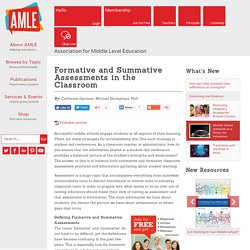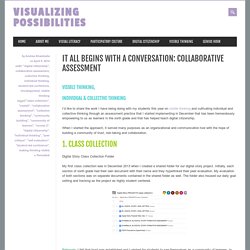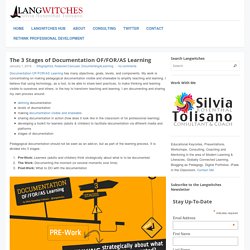

2013 GSI Symposium Breakout Session 2: Formative Assessment. A Report from the Trenches We’re continuing with our reports from the JHU Gateway Sciences Initiative (GSI) 2nd Annual Symposium on Excellence in Teaching and Learning in the Sciences.

Next up is “Assessing Student Learning during a Course: Tools and Strategies for Formative Assessment” presented by Toni Ungaretti, Ph.D., School of Education and Mike Reese, M.Ed., Center for Educational Resources. Please note that links to examples and explanations in the text below were added by CER staff and were not included in the breakout session presentation. The objectives for this breakout session were to differentiate summative and formative assessment, review and demonstrate approaches to formative assessment, and describe how faculty use assessment techniques to engage in scholarly teaching. Summarizing Dr. Assessment is a culture of continuous improvement that parallels the University’s focus on scholarship and research.
Formative and Summative Assessments in the Classroom. Printable article Successful middle schools engage students in all aspects of their learning.

There are many strategies for accomplishing this. One such strategy is student-led conferences. As a classroom teacher or administrator, how do you ensure that the information shared in a student-led conference provides a balanced picture of the student's strengths and weaknesses? The answer to this is to balance both summative and formative classroom assessment practices and information gathering about student learning. Assessment is a huge topic that encompasses everything from statewide accountability tests to district benchmark or interim tests to everyday classroom tests. Defining Formative and Summative Assessments The terms "formative" and "summative" do not have to be difficult, yet the definitions have become confusing in the past few years. Summative Assessments are given periodically to determine at a particular point in time what students know and do not know. References. Educational Leadership:Assessment to Promote Learning:Seven Practices for Effective Learning.
A Typology of Classroom Questions. It all begins with a conversation: collaborative assessment. I’d like to share the work I have being doing with my students this year on visible thinking and cultivating individual and collective thinking through an assessment practice that I started implementing in December that has been tremendously empowering to us as learners in the sixth grade and that has helped teach digital citizenship.

When I started the approach, it served many purposes as an organizational and communication tool with the hope of building a community of trust, risk-taking and collaboration. Digital Story Class Collection Folder My first class collection was in December 2013 when I created a shared folder for our digital story project. Initially, each section of sixth grade had their own document with their name and they hyperlinked their peer evaluation.
My evaluation of both sections was on separate documents contained in the shared folder as well. Rationale: I felt that trust was established and I wished for students to see themselves as a community of learners. A. B. The 3 Stages of Documentation OF/FOR/AS Learning. Documentation OF/FOR/AS Learning has many objectives, goals, levels, and components.

My work is concentrating on making pedagogical documentation visible and shareable to amplify teaching and learning. I believe that using technology, as a tool, to be able to share best practices, to make thinking and learning visible to ourselves and others, is the key to transform teaching and learning. I am documenting and sharing my own process around: defining documentationlevels of doumentationmaking documentation visible and shareablesharing documentation in action (how does it look like in the classroom of for professional learning)developing a toolkit for learners (adults & children) to facilitate documentation via different media and platformsstages of documentation Pedagogical documentation should not be seen as an add-on, but as part of the learning process. Further reading about pedagogical documentation: School Visits, Observations, Documentation, Storytelling Related.
Shifting To 21st Century Learning. Formative vs Summative Assessment. The assessment of teaching and learning can be viewed as two complementary and overlapping activities that aim to benefit both the quality of student learning and the professional development of the instructor.

Assessing learning alone is not sufficient because the ultimate success of students is also dependent upon their motivation and commitment to learning. Similarly, assessing only teaching behaviors and course activities is not sufficient because qualities of the instructor may be appreciated by students but not optimally helpful to their learning and growth.
Formative vs Summative Assessment.